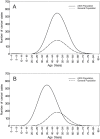Is HIV a model of accelerated or accentuated aging?
- PMID: 24158766
- PMCID: PMC4067117
- DOI: 10.1093/gerona/glt168
Is HIV a model of accelerated or accentuated aging?
Abstract
Background: Antiretroviral therapy has reduced the incidence of adverse events and early mortality in HIV-infected persons. Despite these benefits, important comorbidities that increase with age (eg, diabetes, cardiovascular disease, cancer, liver disease, and neurocognitive impairment) are more prevalent in HIV-infected persons than in HIV-uninfected persons at every age, and geriatric syndromes such as falls and frailty occur earlier in HIV-infected persons. This raises a critical research question: Does HIV accelerate aging through pathways and mechanisms common to the aging process or is HIV simply an additional risk factor for a wide number of chronic conditions, thus accentuating aging?
Methods: Extensive literature review.
Results: The purpose of this review is to briefly outline the evidence that age-related clinical syndromes are exacerbated by HIV, examine the ways in which HIV is similar, and dissimilar from natural aging, and assess the validity of HIV as a model of premature aging. Specific biomarkers of aging are limited in HIV-infected hosts and impacted by antiretroviral therapy, and a high rate of modifiable life style confounders (eg, smoking, substance abuse, alcohol) and coinfections (eg, hepatitis) in HIV-infected participants.
Conclusions: There is a need for validated biomarkers of aging in the context of HIV. Despite these differences, welldesigned studies of HIV-infected participants are likely to provide new opportunities to better understand the mechanisms that lead to aging and age-related diseases.
Keywords: AIDS; Biomarkers of aging; HIV; Immunosenescence; Multimorbidity.
© The Author 2013. Published by Oxford University Press on behalf of The Gerontological Society of America. All rights reserved. For permissions, please e-mail: journals.permissions@oup.com.
Figures


References
-
- CDC. HIV/AIDS among persons aged 50 or over. http://www.cdc.gov/hiv/surveillance/resources/reports/2005report/ 2010
Publication types
MeSH terms
Substances
Grants and funding
LinkOut - more resources
Full Text Sources
Other Literature Sources
Medical

